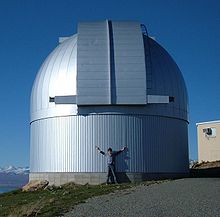Microlensing Observations in Astrophysics
- Microlensing Observations in Astrophysics
-

The Microlensing Observations in Astrophysics (MOA) telescope dome at the top of Mount John
Microlensing Observations in Astrophysics (MOA) is a collaborative project between researchers in New Zealand and Japan, led by Professor Yasushi Muraki of Nagoya University. They use microlensing to observe dark matter, extra-solar planets, and stellar atmospheres from the Southern Hemisphere. The group concentrates especially on the detection and observation of gravitational microlensing events of high magnification, of order 100 or more, as these provide the greatest sensitivity to extrasolar planets. They work with other groups in Australia, the United States and elsewhere. Observations are conducted at New Zealand's Mt. John University Observatory using a 1.8 m (70.9 in) reflector telescope built for the project.
MOA telescope mirror images
Planets discovered
The following planets have been announced by this survey, some in conjunction with other surveys.
See also
References
External links
Wikimedia Foundation.
2010.
Look at other dictionaries:
Microlensing Observations in Astrophysics — Pour les articles homonymes, voir MOA. Le dome du télescope MOA au sommet du Mount John Microlensing Observations in Astrophysics (MOA) est une collaboration entre des chercheurs … Wikipédia en Français
Gravitational microlensing — Gravitational Lensing Formalism Strong lensing … Wikipedia
List of astronomy acronyms — This is a compilation of acronyms commonly used in astronomy. Most of the acronyms are drawn from professional astronomy and are used quite frequently in scientific publications. However, a few of these acronyms are frequently used by the general … Wikipedia
Methods of detecting extrasolar planets — Any planet is an extremely faint light source compared to its parent star. In addition to the intrinsic difficulty of detecting such a faint light source, the light from the parent star causes a glare that washes it out. For those reasons, only a … Wikipedia
Extrasolar planet — Planet Fomalhaut b (inset against Fomalhaut s interplanetary dust cloud) imaged by the Hubble Space Telescope s coronagraph (NASA photo) … Wikipedia
Exoplanetology — is the Art and Science of Exoplanets and the search for Life on other Worlds. It is formally defined as the study of the characteristics, formation and fate of planets outside our solar system. The discovery of extrasolar planets or exoplanets in … Wikipedia
Physical Sciences — ▪ 2009 Introduction Scientists discovered a new family of superconducting materials and obtained unique images of individual hydrogen atoms and of a multiple exoplanet system. Europe completed the Large Hadron Collider, and China and India took… … Universalium
Методы обнаружения экзопланет — Распространённость планетных систем в Млечном Пути в представлении художника[1]. Планеты, вращающиеся около других … Википедия
OGLE-2005-BLG-390Lb — Extrasolar planet List of extrasolar planets An artist s conception of the planet OGLE 2005 BLG 390Lb Parent star Star … Wikipedia
MicroFUN — The Microlensing Follow Up Network (MicroFUN) is an informal group of observers who monitor high magnification gravitational microlensing events in the Milky Way s Galactic Bulge. Its goal is to detect extrasolar planets via microlensing of the… … Wikipedia




